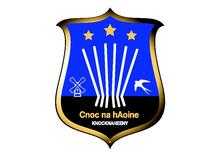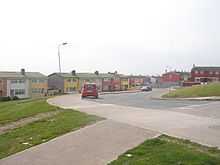Knocknaheeny


Knocknaheeny (Irish: Cnoc na hAoine, Friday's Hill) is a suburb in Cork located north of the River Lee on hills overlooking the city. Knocknaheeny consists mainly of terraced Council housing.
Apple Computer's European base, located between Knocknaheeny and Hollyhill is a large local employer.
History
Knocknaheeny is a relatively new community: today some 4,500 people live in the area,[1] but up until the early 1970s it consisted of rolling countryside bordering on the Gurranabraher, Churchfield and Farranree areas. Cork City Council, known then as Cork Corporation, began to house and rehouse people who lived in slightly older areas of the city, mainly those who grew up in neighbouring Churchfield, Farannree, or Gurranabraher (gurann)and who wished to be closer to their families. In the late 1970s and 1980s, Knocknaheeny had a very young population. The local primary school Scoil Mhuire ar Cnoc na hAoine (st. Mary's on the hill), was granted extensions to the school to cope with over-populated classrooms. Scoil Mhic Shuibhne (now Terence McSwiney Community College) was opened in 1979, the first VEC (Vocational Educational Committee) mixed school. By the end of the 1980s and into the 1990s, the school had a population of over 800 students. But like the other local schools, has seen a drop in numbers to over well under half of that, mainly due to changing demographics and the Celtic tiger enabling many families to relocate and purchase homes in newer estates in villages and towns in Cork county region.
Unemployment was high, in particular in the early to mid-1980s, due to the closure of many local industries, including the Sunbeam, in Blackpool. Opportunities were few for many young people to further their education at universities at that time, however there was a much greater success rate of those attending post-leaving certificate courses, and attending Regional Technical College, Cork ( now known as Cork Institute of Technology). The introduction of programmes in the 1990s that enabled more students to have a greater opportunity in attending university worked with great success. Many local students who didn't attend university or third-level generally returned in later years to achieve that, as all Irish colleges and universities facilitate mature students with great success.
The area suffered from negative press, due to social problems and the problem of joyriding, and people that grew up in the area at this time, often claimed that their applications for jobs were often refused because of where they were from, and people from outside the area generally had misconceptions of them. There was a high turnover of tenants in the area also, and a great many people moved in and out of the area. Many of the original families that moved in at the beginning of the area, still reside there.
Cattle grazed on what is now Harbour View Road and a windmill stood on the site of Killala Gardens. The older townlands were named after plants at the time for instance Knocknaheeny (the Hill of the Rushes), Knocknacullen (Hill of Holly), Knockfree (the Hill of Heather) and Shanakiel (Old Wood or Foxes Wood).

In 1862 Griffith's Land Valuation Survey reported that fifteen families formed the lands of Knocknaheeny, Knocknacullen. They paid rent to the Lord of Cork. One family, Forrest, still farms land near to Clogheen. Having constructed the road system which serves the area the corporation had to name the terraces and avenues of modern Knocknaheeney. They decided to name the individual roads and streets after harbours and coastal areas around the country.
Many of the houses in Knocknaheeny have run into neglect. However over the past few years Cork City Council have made efforts to improve this situation and the area appears to be going through a revitalisation. Development and improvement is now visible all over the area with a new Town Centre currently under construction on Harbour View Road. Residential areas are also popping up with housing now erected at the Reservoir (Rezza) stretching down to Nash's Boreen and the new affordable housing located on Hollyhill Lane and the Shanakiel Development at the top of the Blarney Road.[2]
Much work was put into keeping the houses up to standard, from the 1980s when the felt roof houses were changed to slate, and in the late 1980s where Gas was installed into the homes in order to heat the houses. In the 1990s the windows and doors of those who were tenants of Cork City Council were changed, and field areas and alleys that attracted anti-social behaviour, where blocked off and made an extension of a neighbouring garden, or houses where built in the green areas. However, it was felt by the council, according to local people, that money was being wasted in constantly upgrading and maintaining the area, so plans where put in place in recent years, to demolish the greater part of Knocknaheeny and rebuilt it in phases. Locals were consulted on the plans, and earlier this year the first phase of rehousing all the people in that phase, began. All of the tenants of the council have been rehoused in neighbouring areas, and in recently built houses in Churchfield and Shanakiel, with the option of moving back to their original area when all work is completed. People who had brought their houses from the City Council currently remain in their homes in Knocknaheeny and the Council has began work on demolishing the houses around them.
Area
Schools
Knocknaheeny's primary school is St. Mary's on the Hill which admits both boys and girls. The Secondary School is Terence MacSwiney Community College (formerly Scoil mhic Shuibhne), while it has a Learning Institute in both Saint John's Northside Campus, and the Terence MacSwiney Community College.
Sport
Sporting activities in Knocknheeny are the ever popular GAA sports of Hurling and Gaelic football. In 1943, St Vincent's Hurling and Football club was founded to promote Gaelic games in the Blarney Street and Sunday's Well area, and later expanded to encompass Knocknaheeney, Gurranabraher and Churchfield. The club has won numerous honours: in 1946 the club won the Junior Football County Final; in 1968 the intermediate hurling county title; and a senior hurling league in 1972.
Recent years have brought success at underage level with various teams winning at the premier and A grades. The highlight of this has been the winning of the Minor Premier County in 1998. Some of these players joined with members of other successful underage teams from the 90's to help the club win its first intermediate football title in 2006 and has ensured that the club retained Senior status for the first time since the 70's.
Soccer is a big part of the community, and the local teams are "Knocknaheeny Celtic" (Club colours: Blue/White & Blue) Club Ground: Kilmore Road, Knocknaheeny, and "Grattan United" (Club colours: Blue/White & Blue) Club Ground: O’Neill Park, Knocknaheeny
Knocknaheeny Crest
The Knocknaheeny Crest is Blue and Black in colour and has the Irish title Cnoc na hAoine which translates to Knocknaheeny. The Crest contains three images 1) Reservoir 2) Windmill 3) Swallow. The three stars represent Knocknaheeny, Hollyhill and Knocknacullen.
Transport
Knocknaheeny is served by two bus routes
- 201 Mayfield - Blackpool - Knocknaheeny - Sunday's Well - CIT - CUH
- 202 Knocknaheeny - Gurranabraher - Cork City Centre - Ballintemple - Blackrock - Mahon
Famous People from the Area
- Mark Carroll - Athlete
- Denise O'Sullivan - Football/Soccer
- Tomás Mulcahy - Cork Hurler GAA
References
- ↑ "Combat Poverty Agency". Institute of Public Health in Ireland. Retrieved on 18 April 2009
- ↑ Corporation Web Site